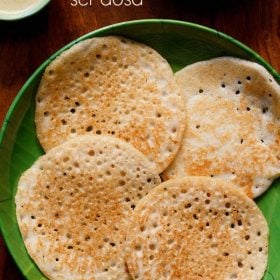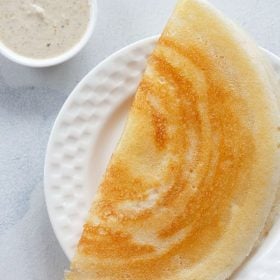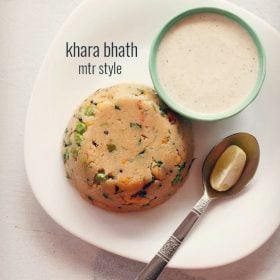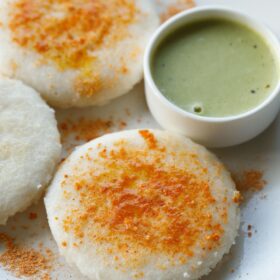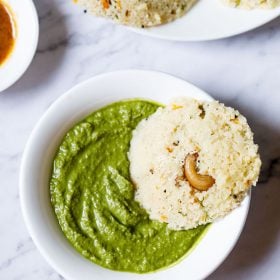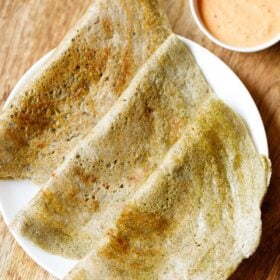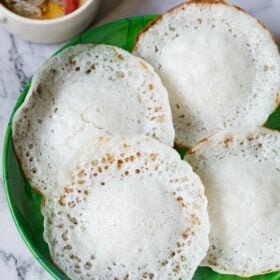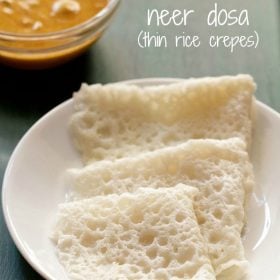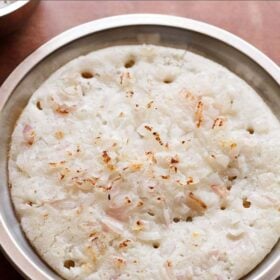Uttapams are the quintessential savory pancakes that are a common breakfast or snack option in South Indian cuisine. There are many ways you can customize a basic recipe at your home. Onion Uttapam is a popular uttapam variant where these pancakes are topped with onions. These can either be topped only with onions or for some heat and spice, green chilies or red chilli powder can also be added on the onion toppings. Whatever it may be, the recipe will result in a delicious dish.
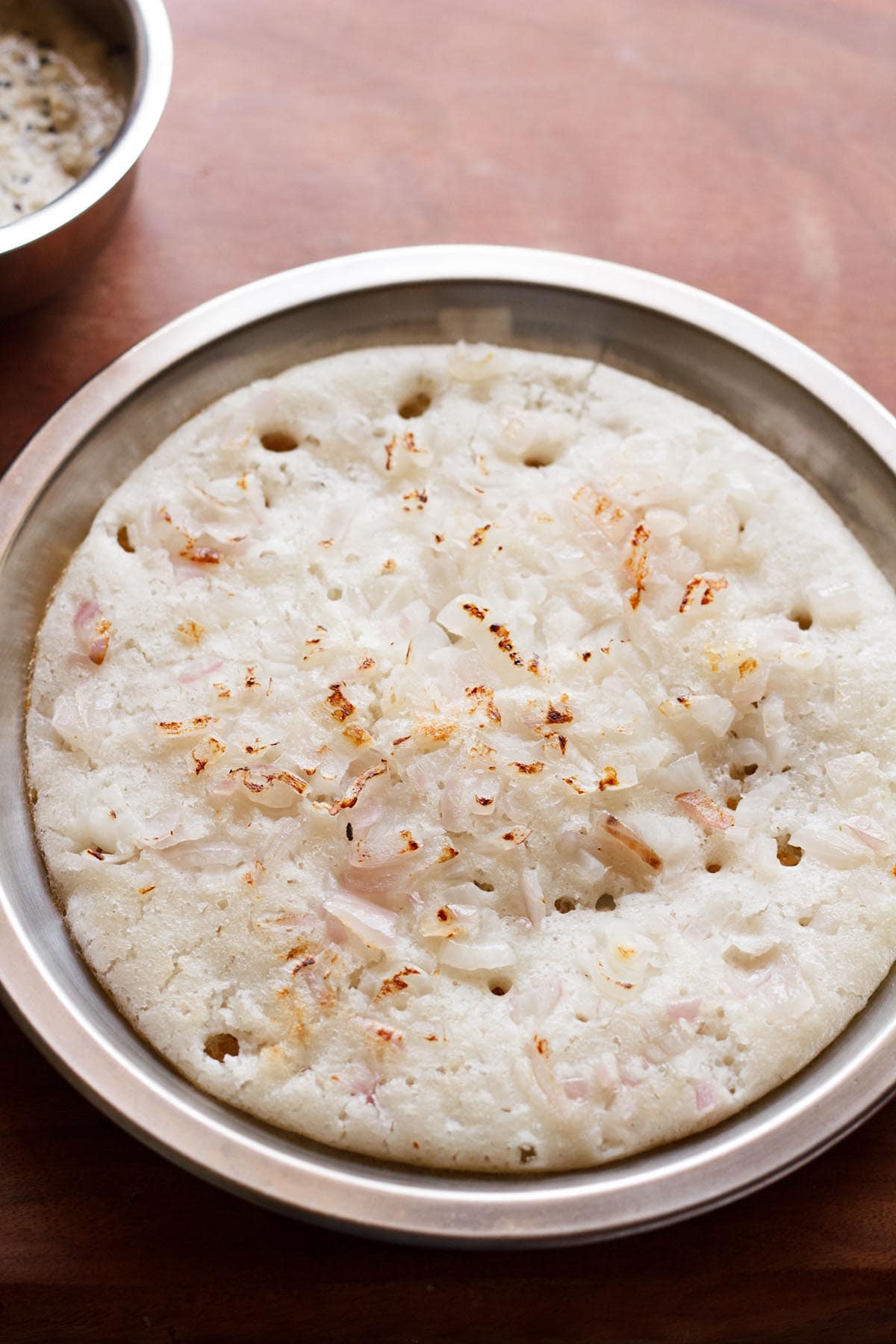
About Onion Uttapam
Imagine a canvas of golden-brown tangy goodness speckled with the vibrant hues of finely chopped onions, each morsel a burst of flavor waiting to delight your taste buds.
That’s the magic of South Indian-style Onion Uttapam, where tradition meets creativity in a culinary symphony.
A popular South Indian dish, Onion Uthappam is a variation of the Traditional Uttapam, a type of savory thick pancake made from fermented rice and lentil batter.
Here I also show you the method of making the rice and lentil batter. Some more uttapam varieties that you may like to explore are:
In Onion Uttapam, chopped onions are added as a topping, giving the dish its distinct flavor and texture. The sweetness of the onions also balances the tangy and sour taste of the batter.
As you ladle the batter onto the sizzling hot griddle, it spreads effortlessly, forming a lacy pattern that hints at the delicate balance of flavors to come. But it’s the addition of onions that transforms this humble pancake into a masterpiece.
The chopped onions that are scattered across the uttapam, adds a touch of sweetness and a hint of bite to each morsel.
They caramelize gently as the uttapam cooks, infusing it with their savory essence and creating a symphony of textures – the crisp edges, the fluffy center, and the tender onions melding harmoniously.
As you flip the Onion Uttapam, revealing its perfectly golden underside, you know that this is more than just a breakfast dish – it’s a celebration of flavors, and a testament to the rich culinary heritage of South India.
More On The Recipe
In this post, I have showed 2 versions of the Onion Uttapam that I prepare at home:
- Made with only onions and is kid-friendly
- Topped with a mix of onions, green chilies and herbs
Instead of onions, you can also use small onions or shallots or pearl onions for this recipe of Onion Uttapam.
The slightly caramelized sweetish onions blend beautifully with the tangy taste of the cooked uttapam.
Some Sambar Powder or Pav Bhaji Masala can also be sprinkled on the onions. You can either use leftover Idli Batter or Dosa Batter or make a fresh batch of batter for this recipe, like I have shown here.
While onions are the primary topping, you can also add other ingredients like chopped tomatoes, green chilies, coriander leaves, grated carrots, or even cheese to enhance the flavor and visual appeal of the uttapam. I have also shown a mixture of other ingredients with onions for a variation.
Served piping hot with a side of Coconut Chutney or a bowl of soul-warming Sambar, Onion Uthappam is a wholesome and satisfying breakfast option, enjoyed not only in South India but also in various parts of the country and by people who appreciate South Indian cuisine globally.
How to make Onion Uttapam
Soak Lentils & Rice
- In a bowl, take ½ cup whole husked urad dal and ¼ teaspoon fenugreek seeds. Begin to rinse with water a few times and later drain all the water.
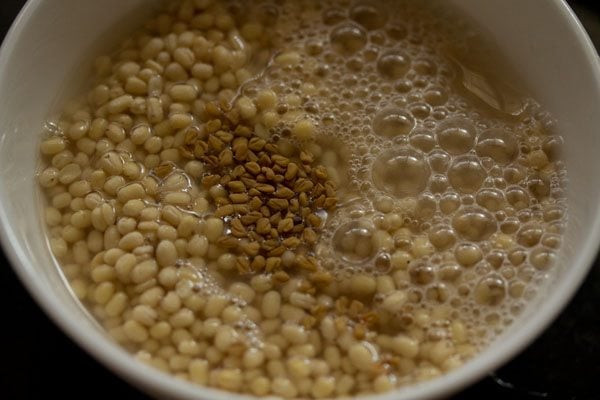
2. Soak the urad dal and fenugreek seeds in enough water for about 4 to 5 hours. Cover with lid and set aside to soak.
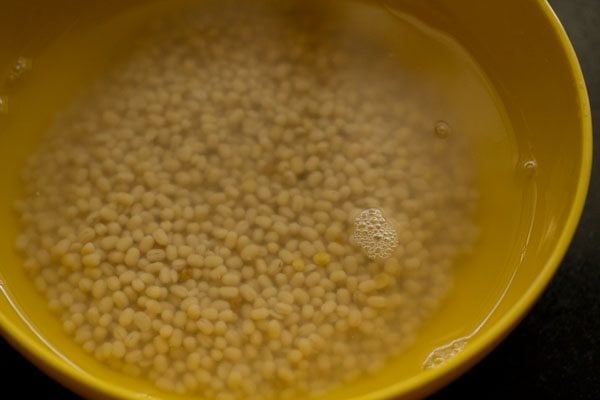
3. In another bowl or pan, take the 2 cups idli rice (or regular rice) and rinse with water a few times. Soak in enough water for 4 to 5 hours.
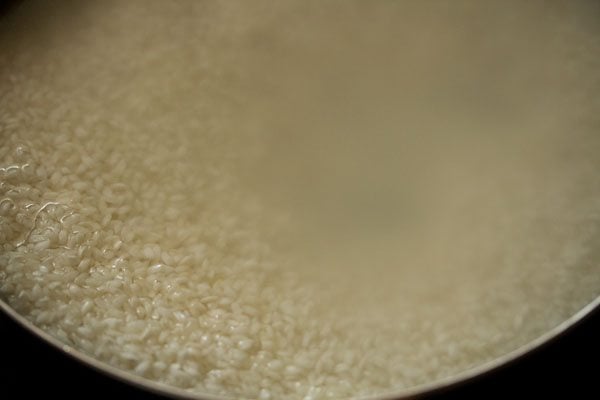
4. Before grinding the urad dal, strain the soaked water in a bowl and reserve it. This soaked water will be used to grind the lentils.
You can also use fresh water, if you prefer, to make the batter.
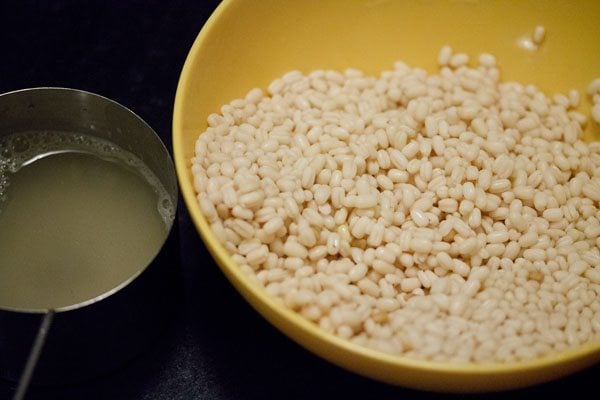
Make Batter
5. Add the soaked urad dal in a sturdy blender or grinder. Add ¼ cup of the reserved soaked water or fresh water and begin to finely grind the lentils.
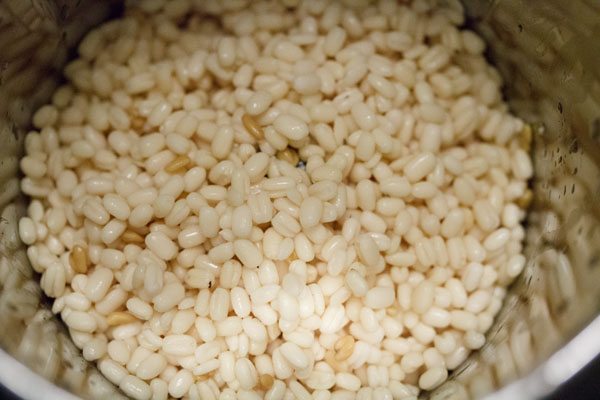
6. Add the remaining ¼ cup of soaked water or fresh water and grind to get a fine, fluffy and smooth batter.
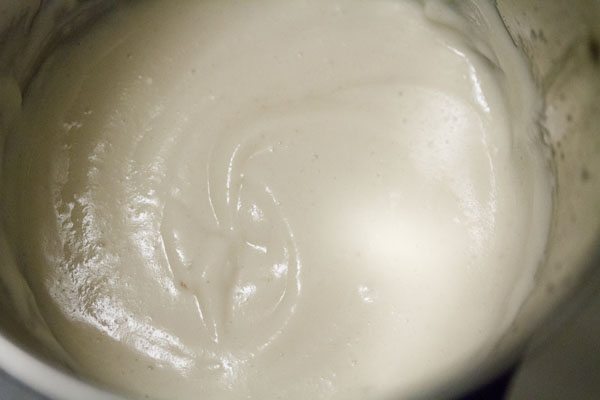
7. Pour the prepared urad dal batter in a large mixing bowl.
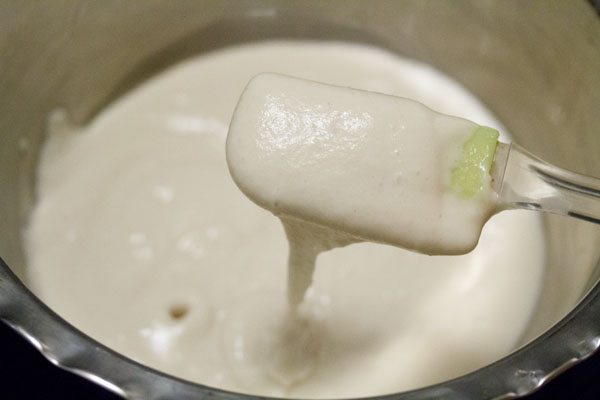
8. In the same grinder or blender, add half portion of the soaked idli rice. Drain the water from the rice and add the soaked rice only.
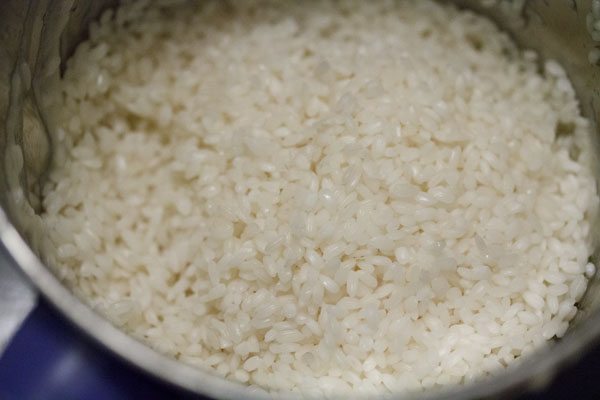
9. Add water and grind to get a semi-fine grainy consistency in the rice batter.
You can also grind the rice in 2 to 3 batches. I usually grind the rice in 2 batches.
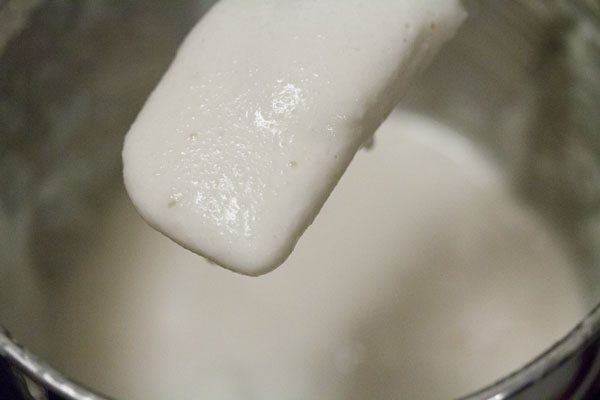
10. Pour the rice batter in the same bowl containing the urad dal batter.
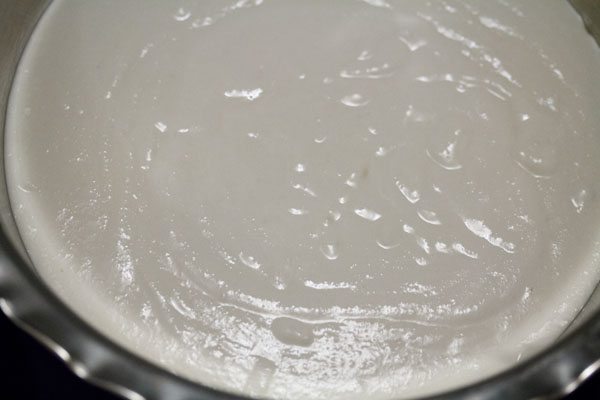
Ferment Batter
11. Add 1 teaspoon edible rock salt, sea salt, pink salt or choose to add salt as needed and according to taste.
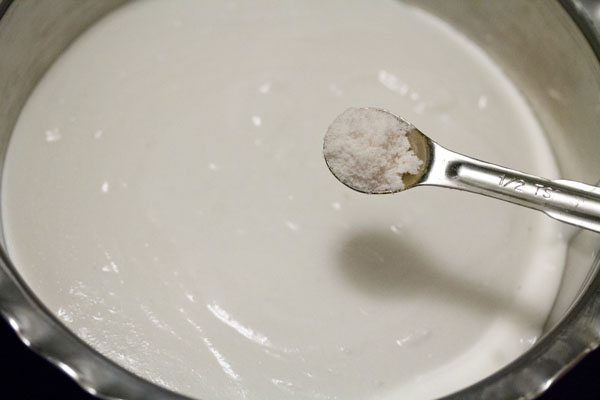
12. Mix the salt and both the batters thoroughly. Cover with lid and let the batter ferment for 8 to 9 hours or overnight.
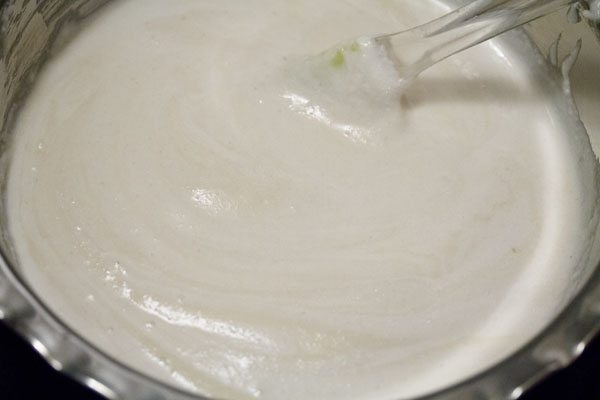
13. The picture below shows the fermented batter. The batter will double or triple in volume after fermentation.
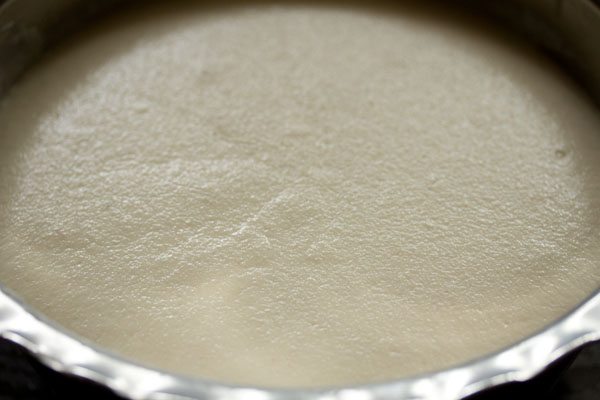
14. When you stir the batter, you will see plenty of air-pockets in the batter. It will have a pleasant fermented aroma.
Check the batter consistency. If its too thick, you can add a few tablespoons of water and mix well.
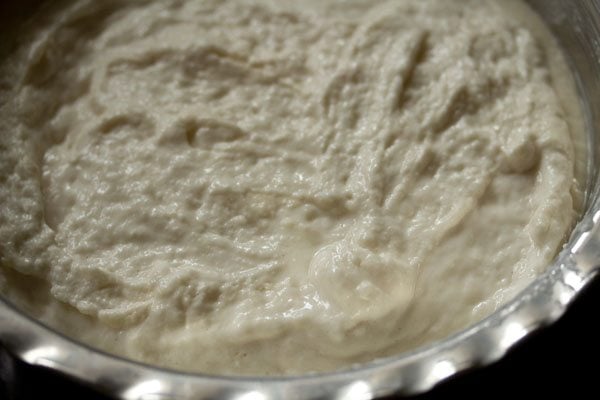
Make Onion Uttapam
15. Heat a tawa or cast iron pan or skillet. Brush or spread some oil on the tawa. For a non-stick pan, you need not grease the pan. The skillet has to be hot.
While making uttapam, you can regulate the heat from low to high. Before pouring the batter, reduce the heat to low.
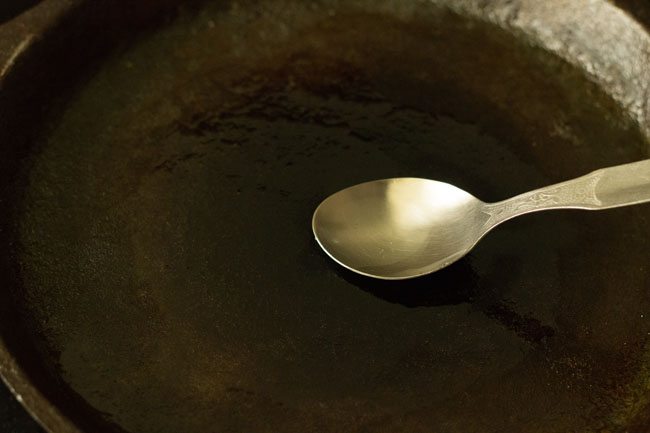
16. Pour the fermented batter with a ladle or spoon.
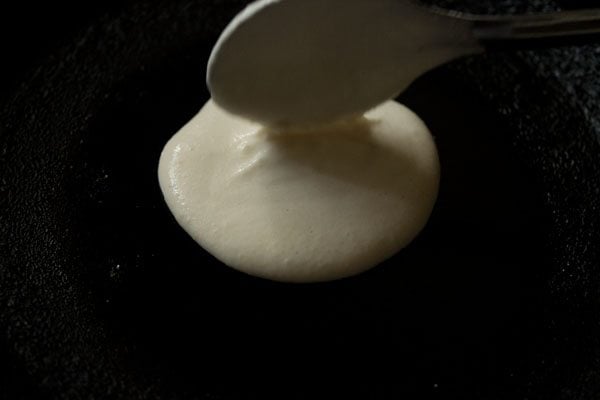
17. Gently, spread the batter to a thick pancake.
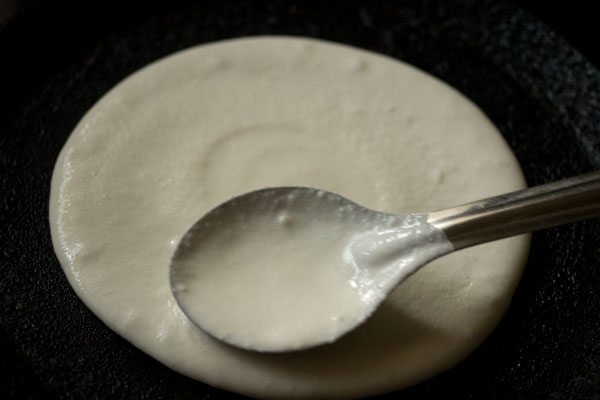
First Method
18. Add some finely chopped onions. With a spoon, lightly press the onions on the uttapam so that they stick to the batter. You can sprinkle a pinch of salt, if you want, all over the uttapam.
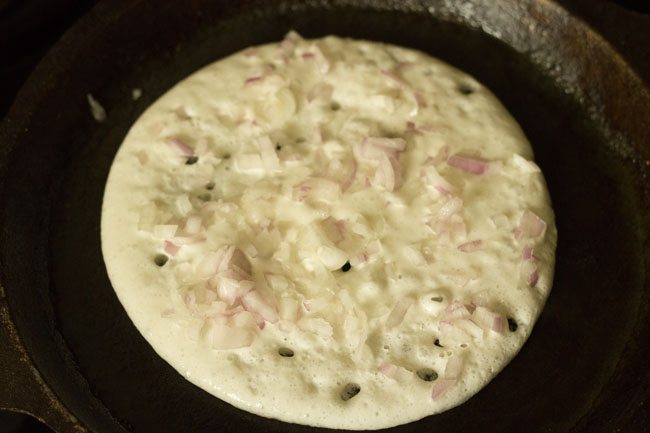
19. Drizzle some oil on the sides and on the uttapam. Cook on medium heat.
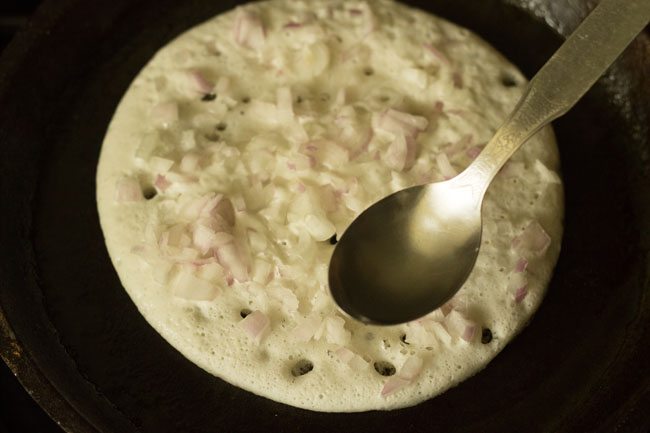
20. When the base turns golden and crisp, gently flip it using a spatula.
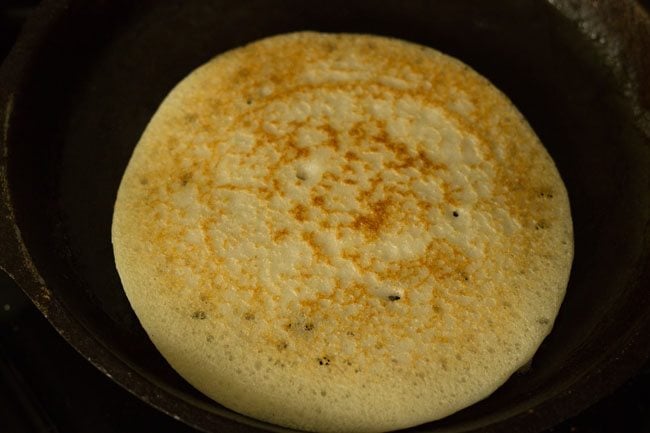
21. Cook the side with the onions until the onions caramelize. You can gently press with the spatula so that some uncooked batter also gets cooked well.
If the uttapam is not cooked well, there will be raw uncooked batter in the center. So, make sure to cook it properly.
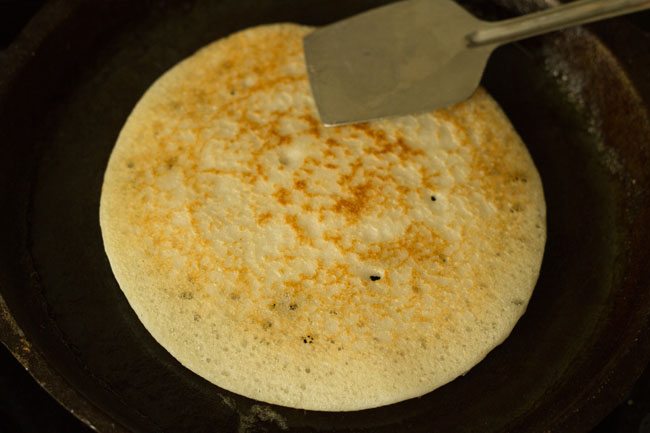
22. Flip over to check if this side is cooked well. The onions will also be caramelized. You can caramelize the onions more, if you prefer.
Remove from the pan and serve hot or warm. Proceed to make the remaining uttapams in batches this way.
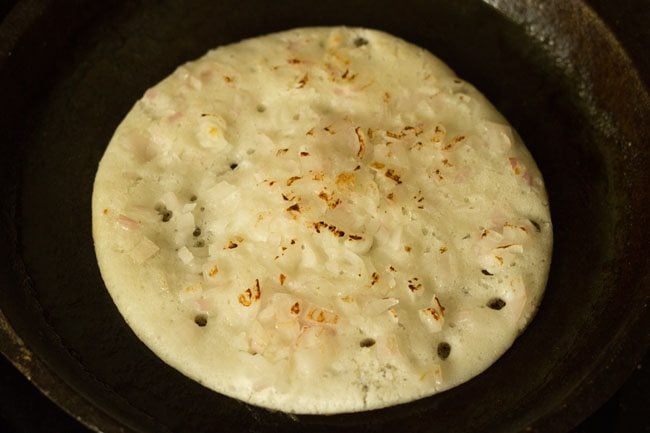
Second Method
23. On a plate, take 1 cup finely chopped onions, 2 or 3 chopped green chilies, 12 to 15 chopped curry leaves and ⅓ cup chopped coriander leaves. Mix very well and keep aside.
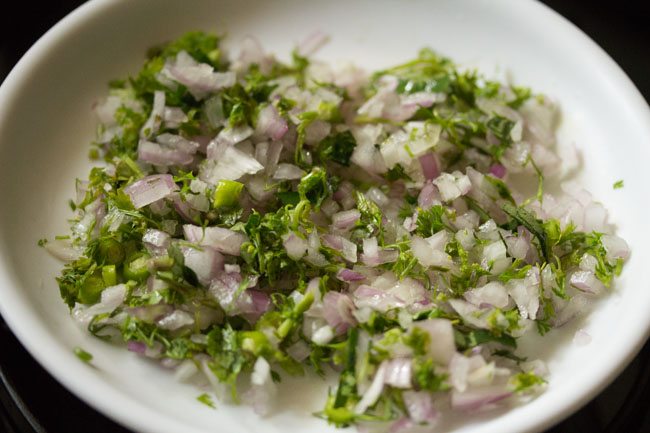
24. Spread the batter on the tawa and top it with the prepared onion mixture. You can sprinkle some salt and Sambar Powder or Idli Podi, if you like.
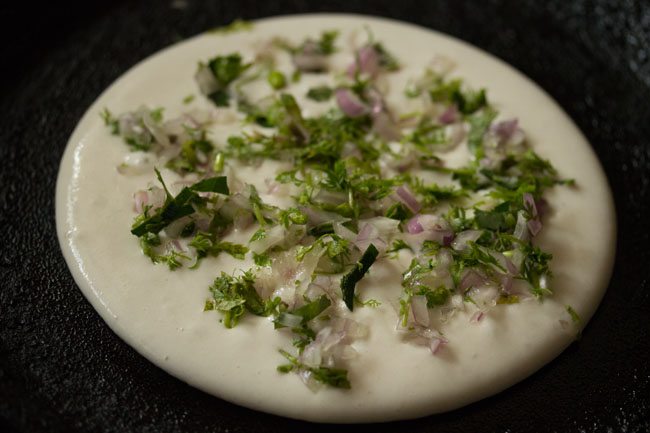
25. Drizzle some oil on the sides and top. Cook uttapam on medium-low to medium heat.
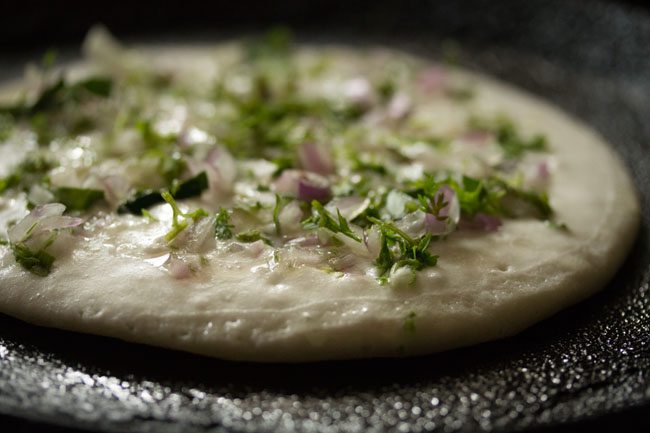
26. Then, turn over and cook till the uttapam as well as the onions, are caramelized.
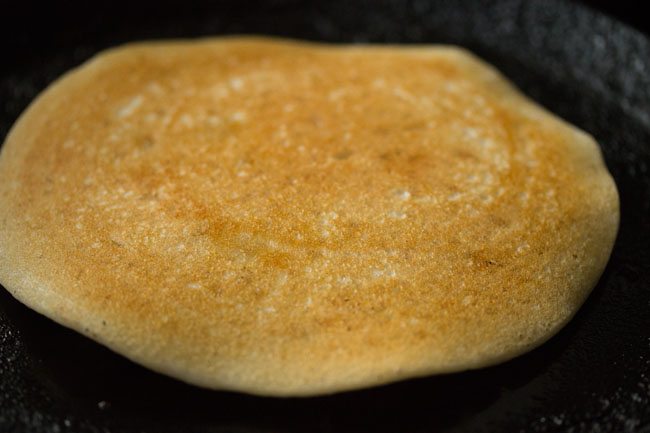
27. Serve Onion Uttapam hot or warm with coconut chutney and sambar. Prepare the remaining onion uthappams in batches this way.
It is best to have these hot or warm. Don’t make in advance as later on you won’t get a better taste of the onions.
Any leftover batter keeps well in the refrigerator for 2 to 3 days. You can make either dosa, uttapam, Paniyaram or appe from the leftover batter.
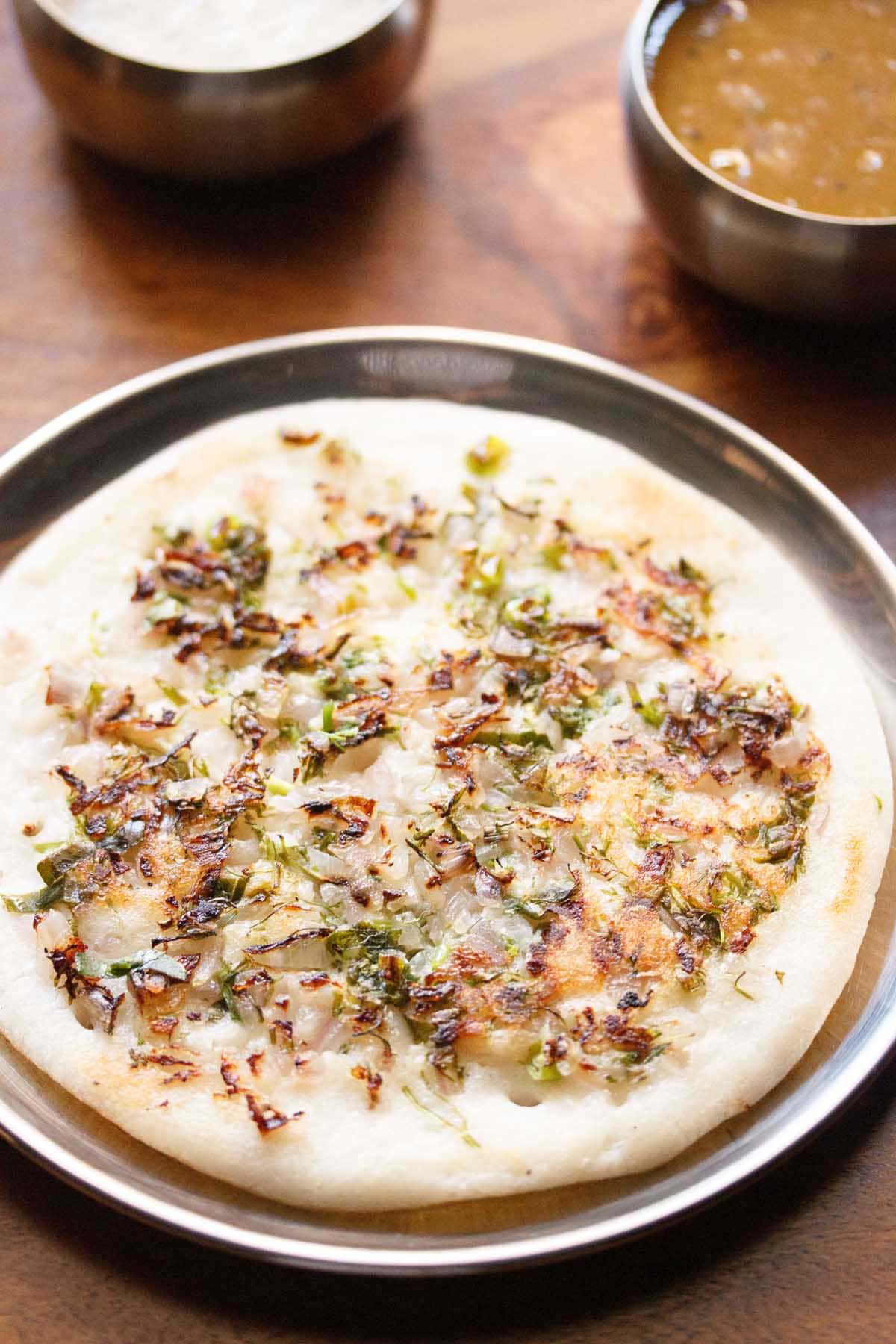
Serving Suggestions
Onion Uttapam pairs nicely with coconut chutney. For an elaborate breakfast or brunch, take some time off to make sambar.
If short of time, consider pairing it with only Peanut Chutney, Coriander Coconut Chutney, Onion Chutney or Tomato Chutney.
You could also pair it with idli podi that has been mixed with some sesame oil or coconut oil.
A quick way is to enjoy these uttapams with some tomato ketchup. Though not traditional but tastes nice.
Expert Tips
- Batter preparation: The key to a good uttapam lies in the batter. It’s typically made from a mixture of rice and urad dal (black gram dal), which is soaked, ground, and fermented overnight. This fermentation process gives the uttapam its characteristic tangy flavor and fluffy texture.
- Consistency of batter: Ensure that the batter for uttapam is of the right consistency – not too thick or too thin. It should be pourable but not runny. Adjust the water or batter consistency as needed to achieve this.
- Preparation of onions: Chop the onions finely for even distribution and quicker cooking. You can also soak the chopped onions in water for a few minutes to reduce their sharpness if desired. For small onions or shallots or pearl onions, consider slicing them.
- Heat level: Preheat the griddle or tawa well before pouring the batter. The surface should be hot enough to sizzle when the batter is poured, but not so hot that it burns the uttapam.
- Spreading batter: Pour a ladleful of batter onto the center of the hot griddle. Use the back of the ladle to gently spread the batter in a circular motion to form a thick pancake. Don’t spread it too thin; uttapam is typically thicker than dosa.
FAQs
Yes, you can use store-bought dosa batter to make Onion Uttapam.
Besides onions, you can add toppings like chopped tomatoes, green chilies, coriander leaves, grated carrots or beets, bell peppers, spinach, or even cheese for variations in flavor and texture.
While onions are a key ingredient in Onion Uttapam, you can make a plain uttapam without onions by omitting them from the batter. The cooking process remains the same.
While a griddle or tawa is traditionally used to make uttapam, you can also use a non-stick pan or skillet to cook it. For a griddle or tawa or skillet, ensure the pan is nicely seasoned and well-heated before pouring the batter.
More South Indian Recipes To Try!
Breakfast Recipes
No Onion No Garlic Recipes
Breakfast Recipes
Breakfast Recipes
Please be sure to rate the recipe in the recipe card or leave a comment below if you have made it. For more vegetarian inspirations, Sign Up for my emails or follow me on Instagram, Youtube, Facebook, Pinterest or Twitter.
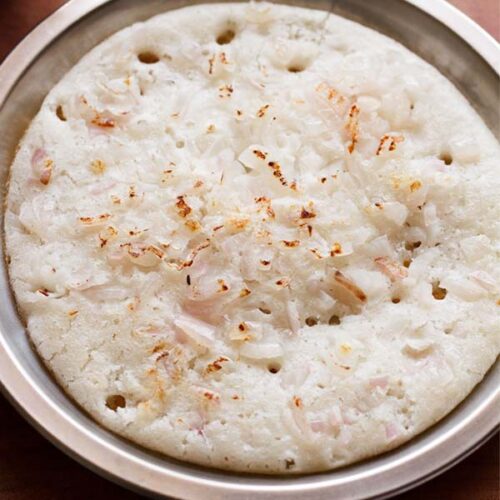
Onion Uttapam (With Homemade Batter)
Ingredients
For batter
- 2 cups idli rice or parboiled rice or regular rice, 400 grams
- 2 cups water – for soaking rice
- ½ cup urad dal (whole and husked), 120 grams
- 1 cup water – for soaking urad dal
- ¼ teaspoon fenugreek seeds (methi seeds)
- ½ cup water – for grinding urad dal or add as required
- ¾ cup water – for grinding rice or add as required
- 1 teaspoon rock salt (edible and food grade) or add as required
For toppings
- 1 cup onions – chopped or sliced shallots or pearl onions
- ⅓ cup coriander leaves – chopped
- 12 to 15 curry leaves – chopped
- 2 to 3 green chilies – chopped
- oil – as required
Instructions
Making batter
- In a bowl take the husked whole urad dal and fenugreek seeds (methi dana). Rinse both the urad dal and fenugreek seeds for a couple of times.
- Then soak these in 1 cup water for 4 to 5 hours.
- In another bowl take the parboiled rice or idli rice. Rinse the parboiled rice or idli rice for a couple of times.
- Add 2 cups water. Mix well and soak everything for 4 to 5 hours.
- Strain the urad dal and reserve the soaked water. Keep this water for grinding the urad dal.
- Add the strained urad dal in the grinder or a sturdy blender.
- Add the reserved water in parts and grind to a smooth and fluffy batter.
- Pour the urad dal batter in a large bowl or pan.
- To the same grinder or blender, add the half of the rice.
- Then add ¼ to ½ cup water and grind till smooth. A fine grainy consistency of rice is also fine in the batter. You can grind the rice in two to three batches. Overall add ¾ cup water for grinding rice.
- Pour the rice batter in the bowl containing the urad dal batter.
- Add 1 teaspoon edible rock salt or as per taste.
- Mix both the batters very well with your hands or a spoon or spatula.
- Cover and allow the batter to ferment overnight for 8 to 9 hours. The timing will vary depending on the temperature conditions in your city.
- The batter should increase in volume and double or triple. Just lightly stir the batter. Check the consistency. If the batter looks too thick, you can add about ⅛ to ¼ cup water or more if required. Mix well.
Making onion uthappam
- Heat up a well seasoned tawa or a cast iron pan, brush or spread some oil on the tawa. For a non stick pan, you need not grease the pan. The tawa has to be hot. While making uttapams, you can regulate the heat from low to high. Before pouring the batter, reduce the heat to low.
- Pour the batter with a ladle or spoon.
- Gently spread the batter to a thick pancake.
First method
- Add some chopped onions. Lightly press the onions on the uttapam so that they stick to the batter.
- Drizzle with some oil on the sides and on the uttapam. Cook on a medium heat.
- When the base becomes golden and crisp, gently flip the uttapam.
- Cook the second side with the onions until the onions are golden or caramelized. You can keep the onions to a light golden, but ensure that the batter is cooked well.
- Optionally, gently press with the spatula so that the any uncooked batter also gets cooked well. If the uttapam is not cooked well, there will be raw uncooked batter in the center. So do make sure to cook it properly.
- Flip over to check if this side is cooked well. The onions will also be caramelized. You can caramelize the onions more if you like.
Second method
- In a plate take the 1 cup chopped onions, 2 or 3 chopped green chilies, 12 to 15 curry leaves (chopped) and ⅓ cup chopped coriander leaves.
- Mix very well and set aside.
- Spread the batter on the tawa and top the onion mixture on the uttapam.
- Drizzle some oil on the sides and top. Cook the uttapam on a medium-low to medium heat. When the bottom looks golden and crispy, turn over.
- Cook the second side with the toppings touching the tawa or skillet, until onions are golden or caramelized.
- Remove and serve. Similarly repeat making the onion uttapam in batches.
- Serve Onion Uttapam hot or warm with coconut chutney and sambar.
Notes
- Opt to make the Onion Uttapam with small onions, shallots or pearl onions instead of regular onions.
- Customize the onion topping according to your preferences. Consider adding some grated carrots or beets, shredded cabbage, or chopped tomatoes.
- You could also sprinkle your favorite spices or spice blend on the onion toppings. Options are red chilli powder, black pepper powder, cumin powder or sambar powder, idli, podi, pav bhaji masala powder and also garam masala powder.
- The fermentation of the batter largely depends on the temperature conditions. Keeping this in mind, the batter can take more time to ferment in a cool temperature.
Nutrition Info (Approximate Values)
This Onion Uttapam recipe from the archives was first published on January 2017. It has been updated and republished on June 2024.
